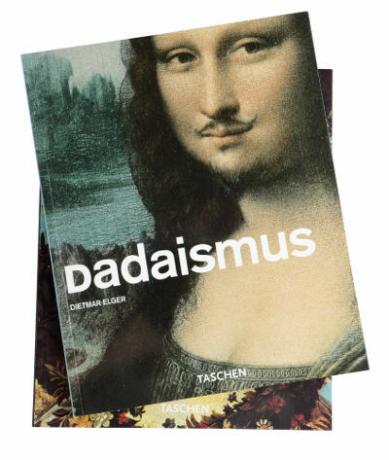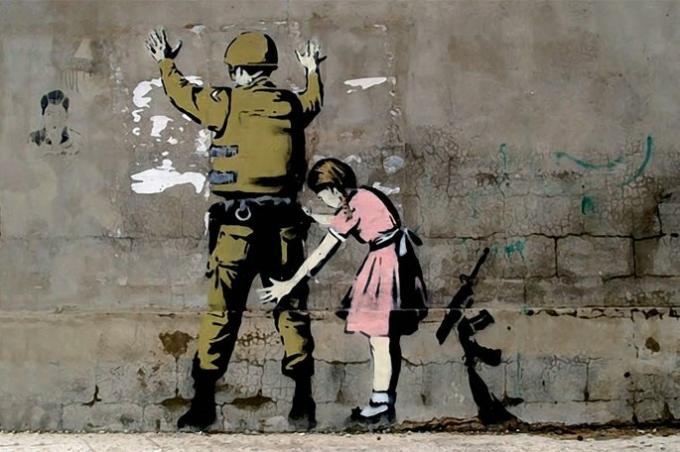O Dadaism, or given (hobby horse, in French), was a movement and cultural phenomenon that occurred from 1916 to 1922 in some countries in Europe and in the United States (USA). Unlike other artistic styles that contemplated the art and pictorial aesthetics, Dada questioned what was the purpose of art and its cultural value.
Considered an avant-garde movement that proposed the anti-art, Dadaism had as representatives artists and intellectuals of different nationalities, especially Germans, French and Romanians. The Dadaists' form of expression was illogical,destructive and at the same time, funny and childish.
How did Dadaism start?
Dadaism began at the end of First World War, in Europe, as a literary and artistic movement. However, over time, it took other directions, following the line of protest art.
In the post-war period, Europe was in a delicate moment, given the events full of horrors and absurdities that marked the war. As a form of criticism and challenge to the consequences of the First World War
, in particular what was considered art at the time, some artists thus created the ideology given.integrated the movement given plastic artists, writers, actors, painters, musicians, poets, doctors, among others. In common, they had feelings of anger, cynicism and disappointment with the events of the time.
the phenomenon given began to take shape in Zurich, in the Switzerland. It then spread to some European cities, such as Berlin, Hanover and Cologne, Germany; and Paris, France. It was also represented in New York, in the United States, with Marcel Duchamp and Francis Picabia.
Second Stephen Farthing, in the book all about art, during World War I, many artists went into exile. In May 1916, German writer and performer Hugo Ball opened the nightclub Cabaret Voltaire, in Zurich. The place started to house other expatriate artists, who, tired of everything they had seen in the recent times, they could vent their feelings of fury in relation to the war, considered by them without sense.
They were angry at European society, which, in their opinion, allowed the war to break out, so they enjoyed challenging the nationalism, rationalism, the materialism and any other “-ism”.
Hugo Ball and the Romanian Tristan Tzara are considered the founders of Dadaism. So much so that Ball read the first Dada manifesto on June 14, 1916. both said that given it was a new art trend.
The idea of the German and Romanian was to invite artists and intellectuals to give presentations and daily readings at Cabaret Voltaire.
Dadaists had their ideals in common. They wanted to go in the opposite direction to what society thought at the time, including against traditions. For this, they decided to go against the artistic expressions of the moment, creating “non-art”. Dadaists believed that art had betrayed humanity.
See too: Art after World War I

(Credit: Public domain / wikimedia)
What does Dadaism mean?
According to specialists, the movement's intention was to create a new form of art, as if it were a child developing his first lines. With this in mind, the word given it's also a reference to a baby's first babble. Studies also show that the word given it had other meanings. See some:
French: "stick horse".
German: "do not bother me"; "please"; "bye"; "to the next".
- Romanian: "Certainly"; "clear"; "you are completely right"; “so it is”; "Yes sir"; "really"; “we've already taken care of that”.
Dada concept
According to studies, Dadaism has the concept of being a movement composed of capricious, colorful, witty sarcastic and, at times, totally silly art.
Who followed the line of given was against society and above all, against art. They wanted to destroy her from an illogical stance. In Dadaism, childishness was celebrated. There was no concern with the visual aesthetic, but with the idea. Meaninglessness was the very meaning.
Dada had the style of "Shock Art”, that is, art to shock people. With this focus, the artists expressed themselves by speaking obscenities, presented eschatological humor, made visual puns, among others.
The objective was to provoke the public, which, at times, felt revolted by the proposed anti-art forms. The Dadaists' intention was to cause shock and indignation with their expressions.
Do not stop now... There's more after the advertising ;)
Dadaism was influenced by Abstraction and the ANDxpressionism. There were also hints of Cubism (gluing techniques) and, to a lesser extent, the Futourism(self-advertising).
Read too: 1922 Modern Art Week
Works of Dadaism

by Marcel Duchamp.
(Image credit: emka74 / Shutterstock.com)
In Dada, materials such as geometric tapestries in glass, plaster and wood relief were used. In addition, the assemblages (in French, collages with materials) and photomontages.
One of the most famous expressions of Dadaism was the photomontages. Artists such as Hans Arp, Raoul Hausmann, George Grosz and Hannah Höch were some of the names that adopted the technique, which consisted of cutting out photographs from newspapers and magazines to create absurd collages and satirical.
These artists put word clippings into a bag, shook it, and took them out one by one. Then they wrote random sentences.
One of the main works of Dadaism is called “The Fountain”, created in 1917 by Marcel Duchamp. The work is a urinal, without piping, in white porcelain.
Another famous work by Duchamp was a copy of Mona Lisa– most famous Italian painting Leonardo da Vinci – with a mustache. On the board, obscenities were scrawled.
Read too:Mona Lisa, neighbor of Da Vinci

“the art critic”, by Raoul Hausmann, is another important work of Dadaism (1919). It contained characteristics of Dada's photomontages: criticism against the system, ironic imagery, self-reference and use of typography.
Dada has influenced numerous literary magazines, such as Chemarea, edited by Tristan Tzara, and Der Dada, by Hausmann. The movement also inspired visual arts currents such as Constructivism. The main artistic movement influenced by Dadaism was the Surrealism.
Cabaret Voltaire
Dadaism is remembered not only for its works, but also for the noisy and provocative performances that took place at the Cabaret Voltaire.
The artists would go on stage at the Cabaret and make nonsense (absurd) presentations, such as hitting the piano, dancing, making costumes, declaiming meaningless poems, among others. Dadaists were very performative.
Some presentations were fiercely critical of the war. Poems were read in three languages, which, according to studies, represented men of different nationalities dying at the same time, in the same place.
One of the memorable presentations was when Hugo Ball he dressed in a shiny metal suit and a cone-shaped hat to recite poetry with syllables and sounds. Some consider Ball the forerunner of phonetic poetry.
Berlin fair
In Berlin, in 1920, the “Erste Internationale Dada Messe”, First Dada International Fair. In total, 174 works were exhibited. The focus of the event was to make a parody of trade fairs.
One of the highlights of the Fair was a tailoring mannequin suspended in the center of the room and dressed in a German officer's uniform and a pig's head made of papier-mâché.
See too: Marginal Poetry
End of Dadaism
Dadaism is thought to have died in 1922, after one of its forerunners, Tristan Tzara, gave a lecture saying that, like everything else in life, Dadaism was useless. In 1924, Dadaism converted to Surrealism with André Breton's manifesto.
Dada was not represented in Brazil, but studies indicate that the book Macunaíma, in mario de andrade, contains characteristics of that movement.
Main names of Dadaism
It is important to emphasize that Dadaism is not an art style like Cubism, Futurism and Surrealism. Besides, it wasn't just made up of artists. Check out the main names below:
Tristan Tzara (Romanian poet)
Hans Arp (German painter and poet)
Hugo Ball (German poet, writer and philosopher)
Francis Picabia (French painter and poet)
Marcel Duchamp (French painter and sculptor)
Man Ray (American painter, photographer and filmmaker)
Max Ernst (German painter)
Kurt Schwitters (German plastic artist)
Hans Richter (German plastic artist)
Richard Huelsenbeck (German poet, musician and doctor)
____________________
¹Image credit: Public domain / wikimedia
By Silvia Tancredi
Brazil School Team



